Zenon Palacz, Isotopx Ltd, Middlewich, Cheshire, UK
Introduction
Thermal Ionization Mass Spectrometers (TIMS) are capable of generating the highest precision and accuracy in isotope ratio determinations. Low mass bias, accurate mass fractionation corrections, high sensitivity and the absence of isobaric interferences are key contributions to a TIMS performance. However, the ability to quantitatively measure ion currents in the picoamp range with minimal calibration are essential ingredients to a precise isotope ratio measurement.
We present isotope ratio data obtained from the Phoenix TIMS equipped with new Xact amplifier boards, which demonstrates the current performance levels of a TIMS.
Xact amplifier boards
The new Xact amplifier boards are mounted within the evacuated and peltier cooled amplifier housing on the Phoenix TIMS. The boards are also back compatible with IsoProbe-T, IsoProbe-P and Sector 54 mass spectrometers.
The board material itself has been designed to be hydrophobic as possible as the presence of residual water in the board material which degasses over time is probably a principal cause of gain instability over time. The resistors have a 25ppm/0C temperature coefficient which is almost 10 times lower than the previous type of resistors which have been in use since the early 1990’s. Since temperature regulation within the amplifier bin is kept to 160C+/-0.020C then the theoretical change in gain would only be 0.5ppm. The amplifier bin is permanently pumped using an oil free scroll pump to minimize any ingress of oil from the pump, and maintain a vacuum of < 0.1mbar.
Faraday Noise
The Noise levels for different integration times of the new boards are shown in Table 1, for both standard 1e11 ohm resistor boards and for boards equipped with 1T resistors. In theory the 1T boards should be 3 times quieter than the 1e11 ohm boards, but this is not the case. The 1T boards are typically 1.4 to 1.8 times quieter than the 1e11 ohm boards, with the biggest benefit occurring for 10 second integrations.
Looking at it another way the noise characteristics for the 1T resistor for a 10 second integration is the same as a 1e11ohm resistor for a 40 second integration. In effect for small ion beams you would have to integrate the baseline or the signal four times longer for the 1e11 ohm resistors than for the 1T resistors. This is clearly where the 1T resistors are advantageous.
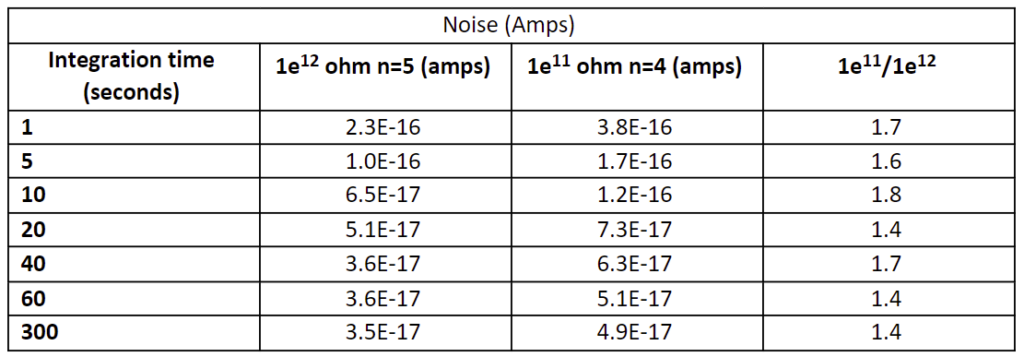
Gain stability
Figure 1 shows gain measurements measured on 9 boards (8 relative to the axial board).
The measurements were made over 25 days on an instrument in a non temperature controlled environment which experienced a minimum of 100C diurnal temperature variation.
The gains (with 1 exception, series2) vary +/-5ppm over this period. The gains appear to vary in a systematic manner, which is highlighted by the excursion at day 12. All the boards seem to show the same variation at the same time. This is variation is probably due to external temperature variations in the environment, and quite possibly due to variations in the stability of the reference voltage which is supplied by the FAC unit which is not temperature regulated.
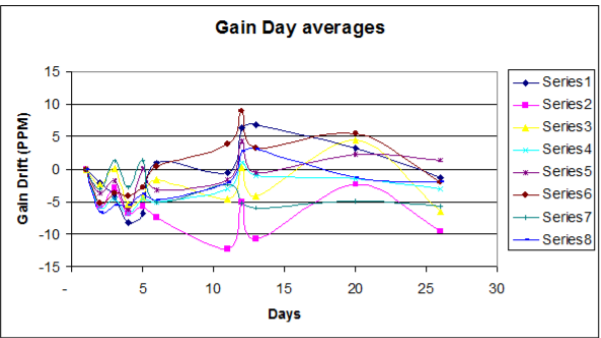
Resistor/Amplifier response (speed)
Figure 2 shows the response of a 1e11 ohm resistor to removal of an 8e-11amp ion signal. The Y co-ordinate shows the intensity in ppm of signal, and the x axis, time in seconds. After 0.5 seconds the intensity is less than 10ppm of the signal, i.e, 8e-16A. After less than 1 second it is at baseline.
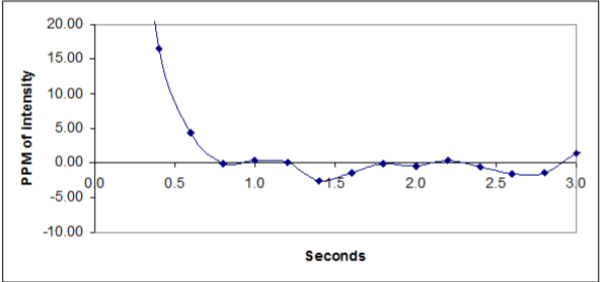
For applications which require fast peak jumping e.g. high precision multidynamic measurements, there is virtually no residual signal within 1 second of a mass jump. For comparison the previous version boards would attain 5ppm of signal within 2 seconds, and the pre-1990 version produced 10ppm of signal within 2 seconds.
Figure 3 shows the response of 1T resistors on the same amplifier board. The figure shows the trace for several resistors, the response is the same. Following an initial overshoot in the first second, there is a rebound, before finally returning to baseline.
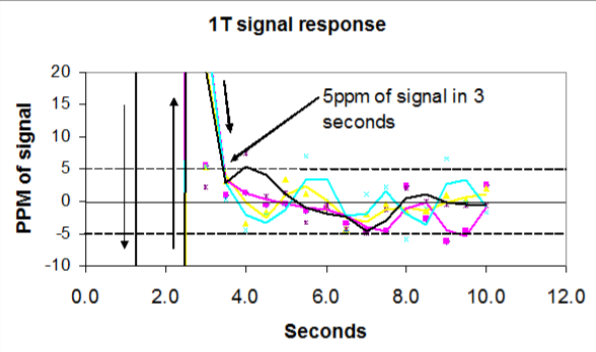
Sr isotope ratio data
High Precision multidynamic measurements would be expected from low noise, fast resistors. Figure 4 is an example of Sr using a 5 volt 88Sr ion beam.The stability of the gain between the detectors is demonstrated by static Sr isotope ratio measurements shown in Figure 5. There is no drift in the data which would indicate a drift in the gain (or a collector efficiency change). The oscillatory nature of the data is probably due to how many baseline measurements were made during the analysis.
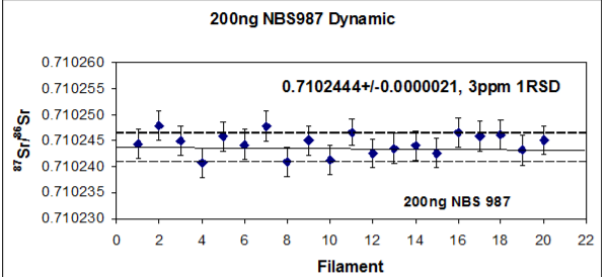
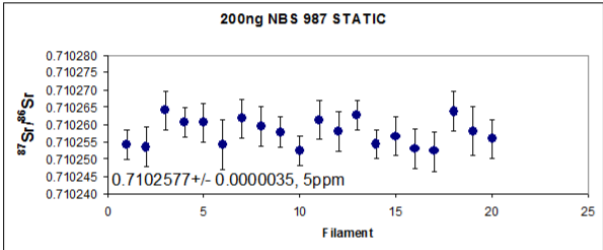
Small sample measurements
The ability to measure small ion signals is shown in Figure 6. Here a Nd ion beam is reduced in size. The errors expand as the ion beam is reduced as would be expected, however, both 1T and 1e11 ohm boards remain coherent down to 1e-13A or 10mv of 142Nd or 4mv of 143Nd. The errors expand below this level.
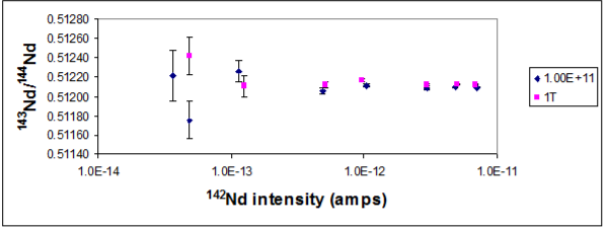
For small sample analyses of Nd, analysis using NdO+ is preferable as the ionization efficiency is about 20% which is ten times higher than Nd+ . Replicate measurements of NdO+ show that for 2 ng of Nd, there is very little difference between 1e11 ohm and 1T resistors, simply because the ion intensities are too high ~2-4e-12A, which is consistent with Figure 7.
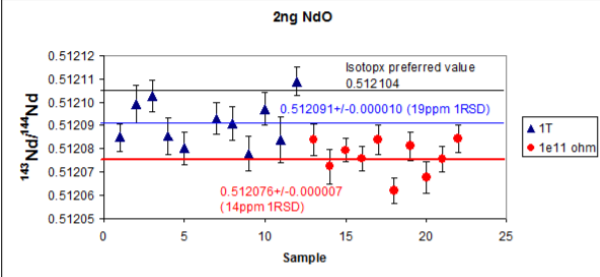
Even for small samples of Sr (<1ng) 1e11 ohm resistors are adequate in producing high precision isotope ratios (Table 2), simply because the ionization efficiency of Sr is very high with TaF activator (>15% for sub nanogram levels)
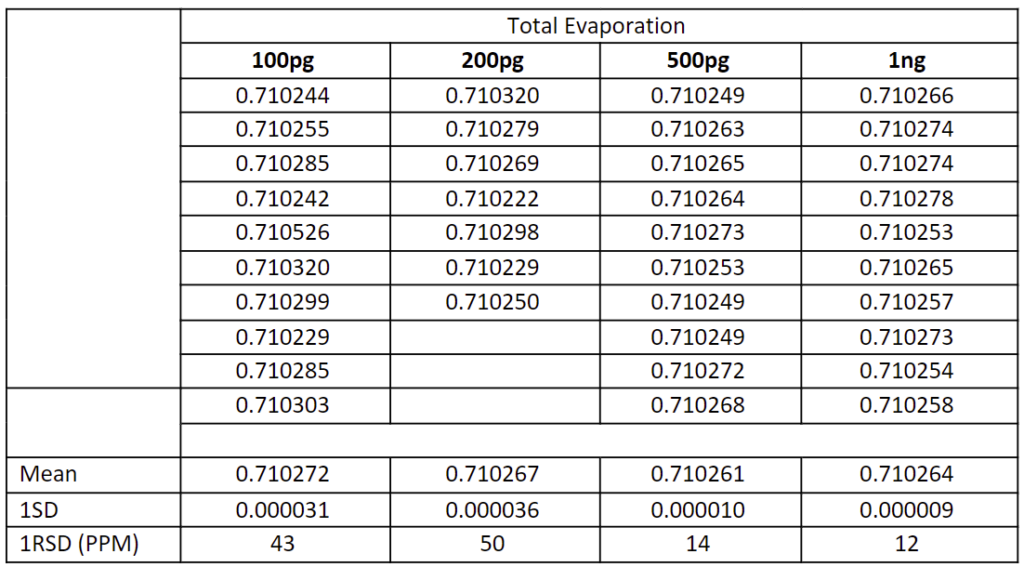
Conclusions
- New Xact amplifier boards are quiet and fast.
- Gain calibrations are stable enough not to require gain calibration be tween samples or the use of dynamic amplifiers.
- Noise levels of 1T resistors are less than 2 times better than 1e11 ohm resistors and do not produce significant benefits for nanogram levels of Nd or >100pg of Sr due to the high ionization efficiency of these elements.
- 1T resistors can probably prove advantageous for very small ion beams (<1e-14A) and for transient ion signals.
Download Poster
Download the complete Poster: Analytical Characteristics of New Faraday Amplifier Boards